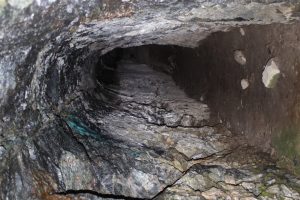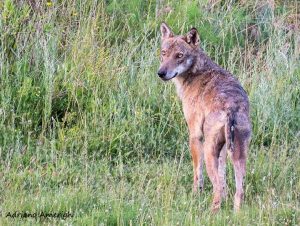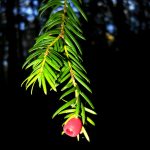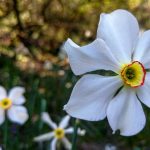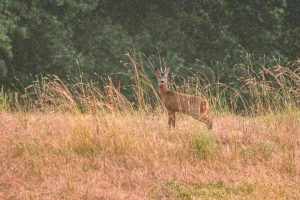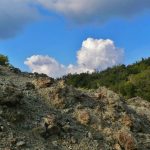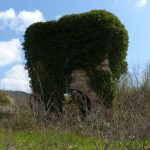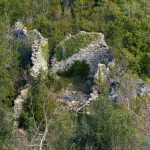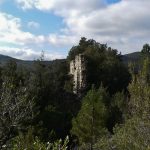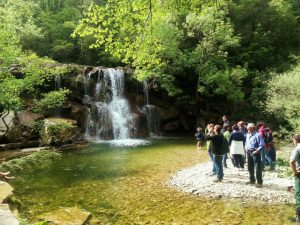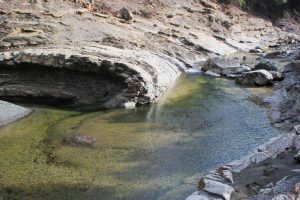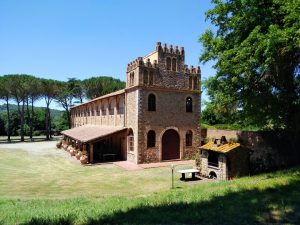
Monterufoli-Caselli Nature Reserve
We are in the wild heart of the Colline Metallifere (Metalliferous Hills), in the territory of the towns of Pomarance, Monteverdi M.mo and Montecatini Val di Cecina.
With its 4,828 hectares, due to the continuous forest cover and the scarce presence of man, the Reserve is today recognised as one of the most important “wilderness” areas in Tuscany, also classified as a Special Protection Zone at European level.
The Reserve is made up of two historic contiguous forest areas separated by the Sterza and Ritasso streams, the larger Monterufoli area to the east in contact with the geothermal zone and the smaller Caselli area to the west that climbs up to the ridge of the Monti della Gherardesca and from where you can see the Tyrrhenian Sea.
We enter places of extraordinary biodiversity where, in an endless hilly forest landscape of thousands of hectares, steep detrital slopes, gorges and torrential shores, and rocky outcrops alternate with wild river ecosystems and arid places close to cool places.
Remote places of immense tranquillity where emotions can be sought by immersing oneself in the crystal-clear waters of the Trossa and Sterza streams, a walk on the “ancient green rocks of snakes” with the colours of very rare blooms, an adventure in the dense thickets with a fleeting encounter with wildlife, discovering a tunnel, a bridge, a ghost building of ancient mines and then the “Villa delle cento stanze” (Villa of the hundred rooms) and a 17th century farm.
The area also stands out for its extreme mining and mineralogical richness: hydrothermal manifestations, abandoned mining landscapes, both on the surface and underground, related to the search for and exploitation of copper, chalcedony, magnesite and lignite, are “buried treasures” to be rediscovered in the Reserve. The vegetal landscape of the Reserve is extremely varied and rich in rarities.
It alternates between Mediterranean scrub, holm-oak woods, high deciduous forests and ancient plants such as yew, holly and laurel to the precious “garigues” on the serpentine rocks, a type of discontinuous vegetation with an important endemic flora of European interest. In the skies, with a bit of luck, you can catch a glimpse of the great short-toed eagle, the “snake eagle”, which nests in the treetops and keeps watch over these large spaces, together with numerous diurnal and nocturnal birds of prey and other rare bird species.
The wolf lives almost undisturbed, hunting wild boars, fallow deer, roe deer and mouflons, while, almost invisible, the wild cat finds refuge in the reserve, together with the marten and many other animals. Walking along the paths of the Reserve offers one surprise after another: a peaceful walk by bicycle or on horseback, using the network of easy trails, or more challenging excursions that do not disappoint trekking lovers, is always an enchanting experience;
the two historical residences of the Reserve offer hospitality and diversified services to facilitate a proper use and knowledge of the protected area.
We are in the wild heart of the Colline Metallifere (Metalliferous Hills), in the territory of the towns of Pomarance, Monteverdi M.mo and Montecatini Val di Cecina.
With its 4,828 hectares, due to the continuous forest cover and the scarce presence of man, the Reserve is today recognised as one of the most important “wilderness” areas in Tuscany, also classified as a Special Protection Zone at European level.
The Reserve is made up of two historic contiguous forest areas separated by the Sterza and Ritasso streams, the larger Monterufoli area to the east in contact with the geothermal zone and the smaller Caselli area to the west that climbs up to the ridge of the Monti della Gherardesca and from where you can see the Tyrrhenian Sea.
We enter places of extraordinary biodiversity where, in an endless hilly forest landscape of thousands of hectares, steep detrital slopes, gorges and torrential shores, and rocky outcrops alternate with wild river ecosystems and arid places close to cool places.
Remote places of immense tranquillity where emotions can be sought by immersing oneself in the crystal-clear waters of the Trossa and Sterza streams, a walk on the “ancient green rocks of snakes” with the colours of very rare blooms, an adventure in the dense thickets with a fleeting encounter with wildlife, discovering a tunnel, a bridge, a ghost building of ancient mines and then the “Villa delle cento stanze” (Villa of the hundred rooms) and a 17th century farm.
The area also stands out for its extreme mining and mineralogical richness: hydrothermal manifestations, abandoned mining landscapes, both on the surface and underground, related to the search for and exploitation of copper, chalcedony, magnesite and lignite, are “buried treasures” to be rediscovered in the Reserve. The vegetal landscape of the Reserve is extremely varied and rich in rarities.
It alternates between Mediterranean scrub, holm-oak woods, high deciduous forests and ancient plants such as yew, holly and laurel to the precious “garigues” on the serpentine rocks, a type of discontinuous vegetation with an important endemic flora of European interest. In the skies, with a bit of luck, you can catch a glimpse of the great short-toed eagle, the “snake eagle”, which nests in the treetops and keeps watch over these large spaces, together with numerous diurnal and nocturnal birds of prey and other rare bird species.
The wolf lives almost undisturbed, hunting wild boars, fallow deer, roe deer and mouflons, while, almost invisible, the wild cat finds refuge in the reserve, together with the marten and many other animals. Walking along the paths of the Reserve offers one surprise after another: a peaceful walk by bicycle or on horseback, using the network of easy trails, or more challenging excursions that do not disappoint trekking lovers, is always an enchanting experience;
the two historical residences of the Reserve offer hospitality and diversified services to facilitate a proper use and knowledge of the protected area.
The tracks of Monterufoli-Caselli Nature Reserve
1 - Golazze Aperte and the Rivivo Valley
2 - The Monterufoli Villa and the Linari valley
3 - The Botticella mines and the Trossa creek
4 - The Ophiolites of Poggio Donato
5 - The Trossa stream and the Farneta point
6 - Grand Tour of Geothermal Energy phenomena and the Parks
7 - Monteverdi: the villages, the countryside and the forests
8 - Campo ai Meli
9 - The Corno al Bufalo ring route
10 - The Poggio Castiglione ring route: an old mining railway in the Ritasso torrent gorge
11 - The Poggio Vecchio ring route
12 - The villages of Micciano and Libbiano and the Monterufoli forest
13 - Querceto Castle and Monterufoli Forest
14 - The Caselli waterfall and the Renzano forest
15 - Sassa, the Caselli forest and the Magona maquis
Monterufoli and Caselli are certainly a treasure trove for botany enthusiasts, but also places where the succession of colours of the vegetation in the different seasons creates suggestions of rare beauty for everyone.
The vast forest landscape and the numerous river environments constitute the dominant element of the Reserve. On the slopes facing south, there are holm-oak woods and typical high scrub formations, where numerous Mediterranean species can be observed, such as strawberry trees, viburnum, heather and phillyrea. Along the Monterufolino nature trail, or in the vicinity of the farm Fattoria di Caselli, visitors can admire the most beautiful holm oak woods in the Reserve, characterised by monumental specimens of trees.
In the shadier and cooler areas, the evergreen woods are replaced by deciduous broadleaf woods such as turkey oaks, downy oaks, oaks and, in the wetter watercourses, hornbeams and ash trees. These woods, together with the vast reforestations of pine trees, create a continuous forest cover that enriches the landscape of the Reserve with colours in autumn. Reaching the most hidden gorges means plunging into particular microclimates where it is possible to find the relict species of the Tertiary period, such as yew, laurel and holly; at that time, between 50 and 2 million years ago, the climate of the region corresponding to Italy was typically tropical.
Lower down, the clear waters of the streams are enclosed in typical riparian vegetation with willows, poplars, ash and alders and, in the Sterza valley, the rare liana Periploca graeca. In the areas with more uneven morphology, and with outcropping ophiolitic rocks, the forest gives way to low scrubland, garrigue and grassland, where the hiker, immersed in the scents of the Mediterranean, will be able to recognise the most important species of flora in the Reserve. Priority habitats at European level with real botanical gardens literally fascinate the visitor.
In these habitats you can observe the rare herbaceous species endemic to the serpentines and be amazed at the extraordinary flowering of the Tyrrhenian Iris (Iris lutescens), the Red Iberis (Iberis umbellata), the Mountain Tulip (Tulipa australis), the Wild Narcissus (Narcissus poeticus), the Tuscan Campanula (Campanula medium) and other species. Orchids are very numerous in the meadow areas, with over 20 species.
Ophiolite vegetation
The soils resulting from the alteration of ophiolite rocks are very inhospitable to plant life due to the lack of nutrients, the presence of toxic heavy metals and high soil temperatures. These conditions have caused the selection of numerous ecological endemisms and have influenced the shape of the plants, most of which are characterised by dwarfism, increased root development, ground-hugging shape with creeping stems, increased hair density, thickening and reduction in leaf size. Real natural bonsai trees of various Mediterranean species fascinate the hiker.
Monterufoli and Caselli are certainly a treasure trove for botany enthusiasts, but also places where the succession of colours of the vegetation in the different seasons creates suggestions of rare beauty for everyone.
The vast forest landscape and the numerous river environments constitute the dominant element of the Reserve. On the slopes facing south, there are holm-oak woods and typical high scrub formations, where numerous Mediterranean species can be observed, such as strawberry trees, viburnum, heather and phillyrea. Along the Monterufolino nature trail, or in the vicinity of the farm Fattoria di Caselli, visitors can admire the most beautiful holm oak woods in the Reserve, characterised by monumental specimens of trees.
In the shadier and cooler areas, the evergreen woods are replaced by deciduous broadleaf woods such as turkey oaks, downy oaks, oaks and, in the wetter watercourses, hornbeams and ash trees. These woods, together with the vast reforestations of pine trees, create a continuous forest cover that enriches the landscape of the Reserve with colours in autumn. Reaching the most hidden gorges means plunging into particular microclimates where it is possible to find the relict species of the Tertiary period, such as yew, laurel and holly; at that time, between 50 and 2 million years ago, the climate of the region corresponding to Italy was typically tropical.
Lower down, the clear waters of the streams are enclosed in typical riparian vegetation with willows, poplars, ash and alders and, in the Sterza valley, the rare liana Periploca graeca. In the areas with more uneven morphology, and with outcropping ophiolitic rocks, the forest gives way to low scrubland, garrigue and grassland, where the hiker, immersed in the scents of the Mediterranean, will be able to recognise the most important species of flora in the Reserve. Priority habitats at European level with real botanical gardens literally fascinate the visitor.
In these habitats you can observe the rare herbaceous species endemic to the serpentines and be amazed at the extraordinary flowering of the Tyrrhenian Iris (Iris lutescens), the Red Iberis (Iberis umbellata), the Mountain Tulip (Tulipa australis), the Wild Narcissus (Narcissus poeticus), the Tuscan Campanula (Campanula medium) and other species. Orchids are very numerous in the meadow areas, with over 20 species.
Ophiolite vegetation
The soils resulting from the alteration of ophiolite rocks are very inhospitable to plant life due to the lack of nutrients, the presence of toxic heavy metals and high soil temperatures. These conditions have caused the selection of numerous ecological endemisms and have influenced the shape of the plants, most of which are characterised by dwarfism, increased root development, ground-hugging shape with creeping stems, increased hair density, thickening and reduction in leaf size. Real natural bonsai trees of various Mediterranean species fascinate the hiker.
The tracks of Monterufoli-Caselli Nature Reserve
1 - Golazze Aperte and the Rivivo Valley
2 - The Monterufoli Villa and the Linari valley
3 - The Botticella mines and the Trossa creek
4 - The Ophiolites of Poggio Donato
5 - The Trossa stream and the Farneta point
6 - Grand Tour of Geothermal Energy phenomena and the Parks
7 - Monteverdi: the villages, the countryside and the forests
8 - Campo ai Meli
9 - The Corno al Bufalo ring route
10 - The Poggio Castiglione ring route: an old mining railway in the Ritasso torrent gorge
11 - The Poggio Vecchio ring route
12 - The villages of Micciano and Libbiano and the Monterufoli forest
13 - Querceto Castle and Monterufoli Forest
14 - The Caselli waterfall and the Renzano forest
15 - Sassa, the Caselli forest and the Magona maquis
16 - The Val di Sterza and the Caselli Forest
17 - The Trossa valley and the Frontosini cliffs
Related tracks Monterufoli
1 - Il torrente Trossa e il puntone di Farneta
2 - Le miniere di Botticella e il torrente Trossa
3 - L’anello di Corno al Bufalo
4 - Antiche vie e paesaggi intorno al borgo di Montecatini
Related tracks Caselli
In the vast forests and the thick, almost impenetrable scrubland, it is not easy to come across wildlife. However, in the more remote and cooler areas it is possible to come across ungulates such as roe deer, wild boar, fallow deer and mouflon. In the open areas, the circling of birds of prey often accompanies the visitor.
The territory of the Reserve hosts species and populations of extreme interest. These include carnivores such as the wolf, which has two breeding packs, the wild cat and the marten, and diurnal birds of prey such as the short-toed eagle, but also the honey buzzard, sparrow hawk and, in winter, the red kite.
Among the small birds, the scrub and forest species, such as the whitethroat, stand out, while on the rocky outcrops there is also the nightjar, woodlark, wardbler and, in winter, bunting and corn bunting. The higher elevations are particularly suitable for observing bird migration, especially in autumn, when on certain days hundreds of birds pass through them.
In these environments, especially in summer, water is a rare and localised resource, so the streams and ponds are particularly important. Along the Trossa, Sterza and Adio streams you can observe amphibians such as the italic frog, the yellow-bellied toad and the spectacled salamander, reptiles such as the marsh tortoise and birds such as the grey wagtail, the mallard and the rare dipper.
Near the water, it is also more common to encounter terrestrial species, which come to water or take advantage of the milder microclimate. It is here, for example, that the common tortoise is most likely to be encountered.
Until the 1950s, the woodcutters and charcoal burners were helped by the famous Monterufoli horse, a native breed of horse well suited to clearing forests and bred in the wild by the Della Gherardesca family; today, work is being done to promote it for tourism and recreational purposes and to preserve this breed, which is at risk of extinction.
The world of invertebrates is also extremely interesting; the development of the wood favours certain specialised insects: termites, the stag beetle and many other beetles are widespread, while in the forests, if the winter has been mild, a splendid lepidopteran species known as the two-tailed pasha can become abundant.
Recent research has investigated some wetlands, discovering new species for Tuscany, peninsular Italy and Italy as a whole, such as some Hymenoptera Chrysididae, which are considered postglacial relicts. Also of note is the presence of a butterfly endemic to the Tuscan archipelago, Coenonimpha elbana, which is considered an endangered species due to the excessive tourist impact on the archipelago. These presences bear witness to an environment that is still intact and rich in biodiversity in an area that is located between the Mediterranean region and the European region.
Many of these species are now rare and threatened, so please do not disturb them and stay on the marked paths, limit noise to a minimum, keep your dogs on a leash, do not leave any kind of waste, including food waste, and take the utmost care, especially during the spring period of reproduction.
In the vast forests and the thick, almost impenetrable scrubland, it is not easy to come across wildlife. However, in the more remote and cooler areas it is possible to come across ungulates such as roe deer, wild boar, fallow deer and mouflon. In the open areas, the circling of birds of prey often accompanies the visitor.
The territory of the Reserve hosts species and populations of extreme interest. These include carnivores such as the wolf, which has two breeding packs, the wild cat and the marten, and diurnal birds of prey such as the short-toed eagle, but also the honey buzzard, sparrow hawk and, in winter, the red kite.
Among the small birds, the scrub and forest species, such as the whitethroat, stand out, while on the rocky outcrops there is also the nightjar, woodlark, wardbler and, in winter, bunting and corn bunting. The higher elevations are particularly suitable for observing bird migration, especially in autumn, when on certain days hundreds of birds pass through them.
In these environments, especially in summer, water is a rare and localised resource, so the streams and ponds are particularly important. Along the Trossa, Sterza and Adio streams you can observe amphibians such as the italic frog, the yellow-bellied toad and the spectacled salamander, reptiles such as the marsh tortoise and birds such as the grey wagtail, the mallard and the rare dipper.
Near the water, it is also more common to encounter terrestrial species, which come to water or take advantage of the milder microclimate. It is here, for example, that the common tortoise is most likely to be encountered.
Until the 1950s, the woodcutters and charcoal burners were helped by the famous Monterufoli horse, a native breed of horse well suited to clearing forests and bred in the wild by the Della Gherardesca family; today, work is being done to promote it for tourism and recreational purposes and to preserve this breed, which is at risk of extinction.
The world of invertebrates is also extremely interesting; the development of the wood favours certain specialised insects: termites, the stag beetle and many other beetles are widespread, while in the forests, if the winter has been mild, a splendid lepidopteran species known as the two-tailed pasha can become abundant.
Recent research has investigated some wetlands, discovering new species for Tuscany, peninsular Italy and Italy as a whole, such as some Hymenoptera Chrysididae, which are considered postglacial relicts. Also of note is the presence of a butterfly endemic to the Tuscan archipelago, Coenonimpha elbana, which is considered an endangered species due to the excessive tourist impact on the archipelago. These presences bear witness to an environment that is still intact and rich in biodiversity in an area that is located between the Mediterranean region and the European region.
Many of these species are now rare and threatened, so please do not disturb them and stay on the marked paths, limit noise to a minimum, keep your dogs on a leash, do not leave any kind of waste, including food waste, and take the utmost care, especially during the spring period of reproduction.
The tracks of Monterufoli-Caselli Nature Reserve
1 - Golazze Aperte and the Rivivo Valley
2 - The Monterufoli Villa and the Linari valley
3 - The Botticella mines and the Trossa creek
4 - The Ophiolites of Poggio Donato
5 - The Trossa stream and the Farneta point
6 - Grand Tour of Geothermal Energy phenomena and the Parks
7 - Monteverdi: the villages, the countryside and the forests
8 - Campo ai Meli
9 - The Corno al Bufalo ring route
10 - The Poggio Castiglione ring route: an old mining railway in the Ritasso torrent gorge
11 - The Poggio Vecchio ring route
12 - The villages of Micciano and Libbiano and the Monterufoli forest
13 - Querceto Castle and Monterufoli Forest
14 - The Caselli waterfall and the Renzano forest
15 - Sassa, the Caselli forest and the Magona maquis
As you walk along the trails, you will immediately perceive a territory that is certainly harsh, characterised by impervious detrital slopes, picturesque gorges or rocky outcrops where it is possible to observe the rich endemic flora. Although it does not reach high altitudes, with a maximum height of 594 m at Poggio delle Carbonare, the area’s landscape is dominated by a group of small isolated hills made up mainly of ophiolitic rocks, the so-called “green rocks” that have had a marked influence on the ecology of the entire area. One of these rocks, serpentinite, which is found in many other areas of Tuscany, has been used for centuries as the raw material to embellish numerous religious buildings, often in association with marble.
Ophiolites (from the Greek òphis = snake and lithos = stone) are made up of magmatic rocks, gabbroes and basalts, and metamorphic rocks, serpentinites. They represent an ancient ocean floor, dating back some 180 million years, which was subsequently compressed and raised above sea level following massive movements of the earth’s crust. This origin is confirmed by the constant association of these rocks with deep-sea sediments, such as jaspers or argillites, with Palombini shales, the latter of which can be observed at the Aia al Cerro.
Walking along the course of the Trossa and Secolo streams, or crossing the slopes of the Poggio Corno al Bufalo, allows the hiker to walk on the bottom of an ancient emerged ocean, a unique experience that together with the numerous traces of mining activities, such as those in the Fosso dei Linari (Mine of Caggio), allows us to discover unusual landscapes and the evidence of the research and extraction of cupriferous minerals such as chalcopyrite, bornite, chalcocite and native copper.
The Corno al Bufalo nature trail leads us to the discovery of an abandoned chalcedony quarry, perhaps the most sought-after mineral of undoubted aesthetic value, which made Monterufoli famous in the period between the end of the 16th and mid-19th centuries for supplying the Opificio Granducale delle Pietre dure in Florence, which still gets chalcedony for its own restorations from the Reserve.
The 19th-century “via ferrata” along the Ritasso torrent, which in the 19th century connected the lignite and magnesite mines to the towns and today is the route of a nature trail, gives us an itinerary full of unique suggestions for lovers of geology and mineralogy, as well as old ghost bridges in masonry, suspended on arches embedded in the rock, and trenches dug into the serpentine, which represent real traces of Industrial Archaeology.
As you walk along the trails, you will immediately perceive a territory that is certainly harsh, characterised by impervious detrital slopes, picturesque gorges or rocky outcrops where it is possible to observe the rich endemic flora. Although it does not reach high altitudes, with a maximum height of 594 m at Poggio delle Carbonare, the area’s landscape is dominated by a group of small isolated hills made up mainly of ophiolitic rocks, the so-called “green rocks” that have had a marked influence on the ecology of the entire area. One of these rocks, serpentinite, which is found in many other areas of Tuscany, has been used for centuries as the raw material to embellish numerous religious buildings, often in association with marble.
Ophiolites (from the Greek òphis = snake and lithos = stone) are made up of magmatic rocks, gabbroes and basalts, and metamorphic rocks, serpentinites. They represent an ancient ocean floor, dating back some 180 million years, which was subsequently compressed and raised above sea level following massive movements of the earth’s crust. This origin is confirmed by the constant association of these rocks with deep-sea sediments, such as jaspers or argillites, with Palombini shales, the latter of which can be observed at the Aia al Cerro.
Walking along the course of the Trossa and Secolo streams, or crossing the slopes of the Poggio Corno al Bufalo, allows the hiker to walk on the bottom of an ancient emerged ocean, a unique experience that together with the numerous traces of mining activities, such as those in the Fosso dei Linari (Mine of Caggio), allows us to discover unusual landscapes and the evidence of the research and extraction of cupriferous minerals such as chalcopyrite, bornite, chalcocite and native copper.
The Corno al Bufalo nature trail leads us to the discovery of an abandoned chalcedony quarry, perhaps the most sought-after mineral of undoubted aesthetic value, which made Monterufoli famous in the period between the end of the 16th and mid-19th centuries for supplying the Opificio Granducale delle Pietre dure in Florence, which still gets chalcedony for its own restorations from the Reserve.
The 19th-century “via ferrata” along the Ritasso torrent, which in the 19th century connected the lignite and magnesite mines to the towns and today is the route of a nature trail, gives us an itinerary full of unique suggestions for lovers of geology and mineralogy, as well as old ghost bridges in masonry, suspended on arches embedded in the rock, and trenches dug into the serpentine, which represent real traces of Industrial Archaeology.
The tracks of Monterufoli-Caselli Nature Reserve
1 - Golazze Aperte and the Rivivo Valley
2 - The Monterufoli Villa and the Linari valley
3 - The Botticella mines and the Trossa creek
4 - The Ophiolites of Poggio Donato
5 - The Trossa stream and the Farneta point
6 - Grand Tour of Geothermal Energy phenomena and the Parks
7 - Monteverdi: the villages, the countryside and the forests
8 - Campo ai Meli
9 - The Corno al Bufalo ring route
10 - The Poggio Castiglione ring route: an old mining railway in the Ritasso torrent gorge
11 - The Poggio Vecchio ring route
12 - The villages of Micciano and Libbiano and the Monterufoli forest
13 - Querceto Castle and Monterufoli Forest
14 - The Caselli waterfall and the Renzano forest
15 - Sassa, the Caselli forest and the Magona maquis
High naturalness watercourses characterise the Reserve; however, they have little or no flow during the summer period, when long periods of drought are frequent.
The main streams are the Trossa on the eastern border of the Reserve in the Pomarance area and the Sterza in the westernmost part in the Monteverdi Marittimo area, both tributaries of the Cecina River.
The excellent state of conservation of the “riparian” vegetation, i.e., the banks, characterised by black poplars, black alders, elms, various shrubby willows, white willows and alder buckthorns, and the high quality of the river water, form unique environments of extraordinary beauty and biodiversity, enriched by the presence of outcrops of ophiolitic rock and pigeon grey “palombini” shale. The Trossa is characterised by stretches with impervious beds adorned with large gabbro boulders, folds of palombini shales, pools and rapids. Important fauna are the dipper and the marsh tortoise, as well as fish such as chub, barbel and roach.
The Sterza is characterised by the presence in the vegetation of the banks of a rare liana of ancient origin, widespread in Italy in a few refuge areas in Tuscany and Apulia, the Periploca graeca. The gravel-terraced shores are characterised by garrigue and annual vegetation and occasionally emerging islets. In the stretches where the speed of the current decreases, herbaceous vegetation typical of wetlands such as scirpeti, rushes, sedges and reeds grows and is populated by amphibians and birds linked to wetlands such as herons, kingfishers and moorhens.
One of the best-known locations, for the quality of its water and its enchanting and uncontaminated environment, is undoubtedly the Sterza waterfall in the Caselli area, known as the “Maidenhair” waterfall, due to the abundant presence of the eponymous fern; a true jewel of nature and peace, but also a fragile environment that must be protected. A particularly picturesque stretch of the Trossa is located downstream of the confluence with the Secolo torrent; known locally as the “Grotta Magna”, it is characterised by large gabbro boulders in the sunken bed of the torrent, which twists between pools and small waterfalls of very clear water.
The Rivivo and Ritasso at Caselli and the Adio at Monterufoli are minor watercourses, but authentic naturalistic pearls that cross areas that are entirely wooded and not easily accessible, among the wildest in the Reserve. To fully enjoy the Reserve’s watercourses, a visit in spring or early summer is recommended as there is still sufficient water; however, please remember to pay the utmost attention as this is also a particularly delicate period for the reproduction of birds and amphibians.
IMPORTANT: The watercourses can only be reached near the marked paths. For reasons of habitat conservation and safety, it is forbidden to ascend all watercourses except for the stretch between the Masso delle Fanciulle and the Masso degli Specchi in the Berignone Reserve. Ascents and guided excursions can be authorised by the Regional Office that manages the Reserves.
High naturalness watercourses characterise the Reserve; however, they have little or no flow during the summer period, when long periods of drought are frequent.
The main streams are the Trossa on the eastern border of the Reserve in the Pomarance area and the Sterza in the westernmost part in the Monteverdi Marittimo area, both tributaries of the Cecina River.
The excellent state of conservation of the “riparian” vegetation, i.e., the banks, characterised by black poplars, black alders, elms, various shrubby willows, white willows and alder buckthorns, and the high quality of the river water, form unique environments of extraordinary beauty and biodiversity, enriched by the presence of outcrops of ophiolitic rock and pigeon grey “palombini” shale. The Trossa is characterised by stretches with impervious beds adorned with large gabbro boulders, folds of palombini shales, pools and rapids. Important fauna are the dipper and the marsh tortoise, as well as fish such as chub, barbel and roach.
The Sterza is characterised by the presence in the vegetation of the banks of a rare liana of ancient origin, widespread in Italy in a few refuge areas in Tuscany and Apulia, the Periploca graeca. The gravel-terraced shores are characterised by garrigue and annual vegetation and occasionally emerging islets. In the stretches where the speed of the current decreases, herbaceous vegetation typical of wetlands such as scirpeti, rushes, sedges and reeds grows and is populated by amphibians and birds linked to wetlands such as herons, kingfishers and moorhens.
One of the best-known locations, for the quality of its water and its enchanting and uncontaminated environment, is undoubtedly the Sterza waterfall in the Caselli area, known as the “Maidenhair” waterfall, due to the abundant presence of the eponymous fern; a true jewel of nature and peace, but also a fragile environment that must be protected. A particularly picturesque stretch of the Trossa is located downstream of the confluence with the Secolo torrent; known locally as the “Grotta Magna”, it is characterised by large gabbro boulders in the sunken bed of the torrent, which twists between pools and small waterfalls of very clear water.
The Rivivo and Ritasso at Caselli and the Adio at Monterufoli are minor watercourses, but authentic naturalistic pearls that cross areas that are entirely wooded and not easily accessible, among the wildest in the Reserve. To fully enjoy the Reserve’s watercourses, a visit in spring or early summer is recommended as there is still sufficient water; however, please remember to pay the utmost attention as this is also a particularly delicate period for the reproduction of birds and amphibians.
IMPORTANT: The watercourses can only be reached near the marked paths. For reasons of habitat conservation and safety, it is forbidden to ascend all watercourses except for the stretch between the Masso delle Fanciulle and the Masso degli Specchi in the Berignone Reserve. Ascents and guided excursions can be authorised by the Regional Office that manages the Reserves.
The tracks of Monterufoli-Caselli Nature Reserve
1 - Golazze Aperte and the Rivivo Valley
2 - The Monterufoli Villa and the Linari valley
3 - The Botticella mines and the Trossa creek
4 - The Ophiolites of Poggio Donato
5 - The Trossa stream and the Farneta point
6 - Grand Tour of Geothermal Energy phenomena and the Parks
7 - Monteverdi: the villages, the countryside and the forests
8 - Campo ai Meli
9 - The Corno al Bufalo ring route
10 - The Poggio Castiglione ring route: an old mining railway in the Ritasso torrent gorge
11 - The Poggio Vecchio ring route
12 - The villages of Micciano and Libbiano and the Monterufoli forest
13 - Querceto Castle and Monterufoli Forest
14 - The Caselli waterfall and the Renzano forest
15 - Sassa, the Caselli forest and the Magona maquis
A wild land today, but with the signs of a centuries-old human presence, for many years the vast landed estate of noble families, managed on a sharecropping basis and exploited for the treasures of the subsoil. The vast reforestations of Monterufoli and Caselli, the coppice form of the woods and the signs of the ancient charcoal pits tell the story of generations of woodcutters, who for centuries walked the mule tracks today used by visitors. Helping the woodcutters and charcoal burners was the famous Monterufoli horse, an indigenous breed of horse well suited to clearing the woods and traversing the narrow paths. In the areas closest to the ruined farmsteads there are remnants of abandoned pastureland, now shrubbery, where in the past wild cattle breeding affected the livelihood of the sparse population in the area. The fortified settlements in the area served to defend and control the mines, but also the trade routes that presumably involved the valley of the Sterza stream; in particular, it seems that this route was an important route for the ‘transhumance’ of cattle.
Less conspicuous, but nonetheless widespread, are the testimonies of the excavation and mining activities that affected the territory of the Reserve for a long time: a visit to the copper mines on the Linari Torrent, to the lignite mines at Villetta or to the precious chalcedony quarries at Podere Monterufolino is fascinating. This ornamental stone, known as “chalcedony of Volterra”, became world-famous when, at the end of the 16th century, Grand Duke Ferdinand I encouraged its use at the Opificio delle Pietre Dure in Florence.
Not to be missed is a visit to the remains of the private lignite railway line that connected the Villetta mine with Casino di Terra from 1872 to 1928. Railway bridges with breathtaking arches run along the course of the Ritasso torrent, in a wild landscape rich in fauna and flora. At the centre of the Reserve, in the heart of the forest, is the 17th-century Villa di Monterufoli, a building of historical and artistic importance, once owned by a noble Volterra family and now an environmental education centre.
A privileged place for visiting the protected area and the starting point for the most interesting trails, the Villa, also known as “delle cento stanze” (of the hundred rooms), stands on a rise where a rural castle once belonged to the Bishops of Volterra. When the Maffei family took possession of the estate in 1533, they mainly exploited the mineral resources of this part of the Colline Metallifere, an activity that intensified from the mid-1800s until the early decades of the 1900s with the Della Gherardesca nobles.
A building complex of historical interest, the Caselli farm dominates the territory of the ancient feud of the same name, once owned by the Della Gherardesca counts and known since the early Middle Ages. After its past as a castle, then as a villa and a farm with variety of production activities, it is now a multi-purpose centre for accommodation, education and research that enhances and preserves the precious environmental resources of these territories.
A wild land today, but with the signs of a centuries-old human presence, for many years the vast landed estate of noble families, managed on a sharecropping basis and exploited for the treasures of the subsoil. The vast reforestations of Monterufoli and Caselli, the coppice form of the woods and the signs of the ancient charcoal pits tell the story of generations of woodcutters, who for centuries walked the mule tracks today used by visitors. Helping the woodcutters and charcoal burners was the famous Monterufoli horse, an indigenous breed of horse well suited to clearing the woods and traversing the narrow paths. In the areas closest to the ruined farmsteads there are remnants of abandoned pastureland, now shrubbery, where in the past wild cattle breeding affected the livelihood of the sparse population in the area. The fortified settlements in the area served to defend and control the mines, but also the trade routes that presumably involved the valley of the Sterza stream; in particular, it seems that this route was an important route for the ‘transhumance’ of cattle.
Less conspicuous, but nonetheless widespread, are the testimonies of the excavation and mining activities that affected the territory of the Reserve for a long time: a visit to the copper mines on the Linari Torrent, to the lignite mines at Villetta or to the precious chalcedony quarries at Podere Monterufolino is fascinating. This ornamental stone, known as “chalcedony of Volterra”, became world-famous when, at the end of the 16th century, Grand Duke Ferdinand I encouraged its use at the Opificio delle Pietre Dure in Florence.
Not to be missed is a visit to the remains of the private lignite railway line that connected the Villetta mine with Casino di Terra from 1872 to 1928. Railway bridges with breathtaking arches run along the course of the Ritasso torrent, in a wild landscape rich in fauna and flora. At the centre of the Reserve, in the heart of the forest, is the 17th-century Villa di Monterufoli, a building of historical and artistic importance, once owned by a noble Volterra family and now an environmental education centre.
A privileged place for visiting the protected area and the starting point for the most interesting trails, the Villa, also known as “delle cento stanze” (of the hundred rooms), stands on a rise where a rural castle once belonged to the Bishops of Volterra. When the Maffei family took possession of the estate in 1533, they mainly exploited the mineral resources of this part of the Colline Metallifere, an activity that intensified from the mid-1800s until the early decades of the 1900s with the Della Gherardesca nobles.
A building complex of historical interest, the Caselli farm dominates the territory of the ancient feud of the same name, once owned by the Della Gherardesca counts and known since the early Middle Ages. After its past as a castle, then as a villa and a farm with variety of production activities, it is now a multi-purpose centre for accommodation, education and research that enhances and preserves the precious environmental resources of these territories.
The tracks of Monterufoli-Caselli Nature Reserve
1 - Golazze Aperte and the Rivivo Valley
2 - The Monterufoli Villa and the Linari valley
3 - The Botticella mines and the Trossa creek
4 - The Ophiolites of Poggio Donato
5 - The Trossa stream and the Farneta point
6 - Grand Tour of Geothermal Energy phenomena and the Parks
7 - Monteverdi: the villages, the countryside and the forests
8 - Campo ai Meli
9 - The Corno al Bufalo ring route
10 - The Poggio Castiglione ring route: an old mining railway in the Ritasso torrent gorge
11 - The Poggio Vecchio ring route
12 - The villages of Micciano and Libbiano and the Monterufoli forest
13 - Querceto Castle and Monterufoli Forest
14 - The Caselli waterfall and the Renzano forest
15 - Sassa, the Caselli forest and the Magona maquis
Managers of Natural Reserves
Info and reservations for guided tours
Stays at the Environmental Education Center of the Monterufoli-Caselli Nature Reserve
More info
Main points of interest

The Ophiolites of Poggio Donato

The Corno al Bufalo ring route

The Poggio Castiglione ring route: an old mining railway in the Ritasso torrent gorge

The chalcedony of Monterufoli
Discover
A very rare oak forest
Discover
Trossa Stream
Discover
The Monterufoli Villa “of the hundred rooms”
Discover
Mining buildings on the Linari stream
Discover
Caselli Farm and Church
Discover
The Caselli or ‘Maidenhair’ waterfall
Discover
The Rivivo stream
Discover
The forest of Renzano
Discover
The Caselli pond
Discover








